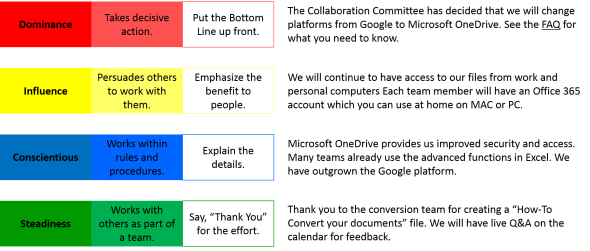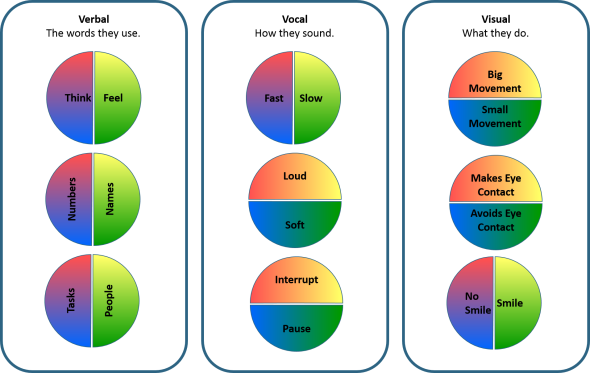Communicating to Personality
Posted: July 22, 2017 Filed under: Uncategorized | Tags: Game, Organizational Behaviors, Personality Leave a commentSet-Up relationships by knowing your communication style
There is a personality test available that allows you to understand the things that others see in your communication style. Knowing this about yourself and others is important to having effective communications. When people are really listening — because you are speaking in a way that they like to hear — your message more often translates to a stronger inter-personal relationship and immediate action.
I use the Color Wheel designations, but you can also use the DISC method. As you will see from the game below, you don’t need to know the model to start trying this out.
The Game is to build relationships by knowing your audience’s communication style.
When meeting someone new, have you ever really, “hit it off” from the start? Your communication style is very compatible, which makes for an enjoyable conversation. Alternately, are there those people that you must interact with that you find tedious and difficult? In this case, you may need to make some more effort in order to be understood.
This game is not to mirror or mimic your conversational partner, it is more to align with them, like two boats navigating to come along side each other.
See the behavior graphic below. When you observe a specific “tell” put a mental mark on that side of the color wheel. The quadrant with the most marks is the color you are dealing with.
For example: 
- I speak in technical terms (numbers, tasks, thinking). That is the LEFT side.
- I modulate my tone (slower, softer, pauses). That is the BOTTOM
- I have big arm movements (TOP), and I smile reactively (RIGHT), but I don’t make eye contact too much (LEFT).
As you can see from my marks, I tend to Conscientious or Blue (BOTTOM, LEFT).
How can I win friends with this?
I try to understand my audience. I watch them, and try to determine what personality they are in today — sometimes it is different. Then, I try to play to their behaviors.
- When talking to Dominance personalities, I stop before I finish explaining, giving them an opening to interrupt with questions they want to ask.
- When talking with Influence or Steadiness personalities, I try more social conventions. I may talk about the people involved or how I can help.
The best way for me to win is to work out what I am going to say and put it in the right order. See this e-mail example, but this also works if you are going to talk to a small group about an idea that you really want to do.
Rule Books
| Presentation (These Graphics) | Brian Suyat, Color Wheel / DISC Behaviors |
| Tool | Manager Tools, DISC Profile |
| Tool | Insights Discovery, Color Wheel |
The Effective Executive
Posted: July 16, 2017 Filed under: Uncategorized | Tags: Book, Management, Organizational Behaviors Leave a commentSet Up
 Peter Drucker may be the most quoted business writer of all time. Every business class, research article, or management book I have read somehow references his wisdom. Over fifty years ago, Mr. Drucker established the basic behaviors of successful executive managers, and we continue to learn them over in our day and age. The Manager-Tools podcast recommends reading this book at least once per year.
Peter Drucker may be the most quoted business writer of all time. Every business class, research article, or management book I have read somehow references his wisdom. Over fifty years ago, Mr. Drucker established the basic behaviors of successful executive managers, and we continue to learn them over in our day and age. The Manager-Tools podcast recommends reading this book at least once per year.
Game Rules
In his 2004 article (he died in 2005 at the age of 96) in Harvard Business Review, What Makes an Effective Executive?, Drucker continues to refine his original concepts. The three that I look to most often are:
Do what is best for the organization
Drucker looks to people’s strengths and how those strengths could be turned to best benefit the organization. He focuses on the contributions of team members that deliver the organization’s desired results. In the Prezi, you see that the only weakness that matters is, “Would I let me son or daughter work with this person?” Every other weakness is acceptable because we must accept those in order to get the strengths that are important to the organization. Our opinions of people are secondary to their results.
Make Decisions, develop Action Plans
Drucker wants effective decisions. He would often create disagreement to his ideas in order to listen to opposing viewpoints. He did not like team leaders to say, “Yes, sir.” Having disagreement provides options, and options ensure that there is a best decision as well as an alternate, Plan B, if necessary.
Run productive meetings
The best example of Drucker running meetings is his ability to focus on one thing at a time. If everything is a priority, then nothing is a priority. His ideal meeting discusses one topic at a time, makes a decision and an action plan, then determines a time to check on progress.
A deeper resource for meetings is Let’s Stop Meeting Like This by Dick Axelrod.
See George Ambler, in his blog Helping Leaders Grow, 5 Habits of Effective Executives, for another summary on Drucker’s ideas.
Winning Strategy
When I teach Drucker, it is usually in the context of making decisions and following-up on progress. In my mind, this is the one skill upon which all other management techniques rely.
• Before you Make Decisions in a meeting, encourage disagreement and respectful debate.
• When you Make Decisions, do so for the benefit of the organization.
• When you Make Decisions, immediately make an Action Plan to execute the decision.
Rule Books
- Publisher Page: The Effective Executive
- Article: Harvard Business Review, June 2004, What Makes and Effective Executive
- Blog: George Ambler, 5 Habits of Effective Executives
- Podcast: Manager-Tools, Books to Read (Or Read Again) in 2014
- Compaion Book: The Effective Executive in Action
- Prezi: Brian Suyat, Book Report: The Effective Executive
- For more ways to implement Peter Drucker’s manager behaviors, consider the companion workbook: The Effective Executive in Action.
See the full list of What’s this Book for more summaries of the most influential books in organizational rules.

